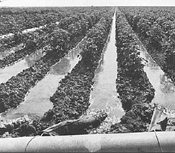
by Jim Hight

After years of research and tinkering, a federal-local committee of river experts is on the verge of announcing a new "flow regime" for the troubled Trinity River. Early reports indicate the committee will recommend that more water flow down the river channel from Lewiston Dam, with releases staged to mimic natural conditions, including periodic floods.
But sending more water west means less water will flow east and south to irrigate thirsty Central Valley farms. And in May agricultural interests won the latest round of legal-political conflict over Trinity water by blocking an increase in westbound water.
What they stopped was a one-year proposal to "ramp up" spring and summer flows to help salmon and steelhead smolts migrate downriver. The program was hurried through after it became apparent that the long-term flow recommendations wouldn't be completed until December 1997, more than a year later than expected.
But on May 23 -- the same day that dam operators began the temporary flow regime -- lawyers for the San Luis and Delta Mendota Water Authority secured an injunction against the flow increase from a federal judge in Fresno. "We were half a day into it when we were handed the restraining order," said bureau engineer Paul Fujitani.
The San Luis group's complaint cited inadequate scientific data and violations of the stringent public-input laws for such changes in federal environmental policies. The government has not appealed the decision.
Trinity defenders issued an angry press release headlined "Corporate Farmers Use Environmental Law to Steal Trinity River Water," but the May fracas was really just a warm-up for the contest to come when the final flow regime is unveiled.
"That was just sort of a blip on the radar screen," said Tom Stokely, a Trinity County planner who's working on the flow studies. "The document we're working on will be for a permanent Trinity flow regime."
The attorney for the water authority said that his clients might support the permanent plan if it is "prepared in a manner that is consistent with the law and based on sound science," said Tom Birmingham. But North Coast Trinity defenders are skeptical, noting the economic self-interest of the water authority membership, which includes farmers in seven counties south and east of Stockton.
"If they find it to be scientifically sound, they'll find another reason to argue against it," said Tom Weseloh, spokesman for California Trout.
But Weseloh and other Trinity activists are hoping that the final flow regime report is so legally and scientifically watertight that it will survive the expected challenges. "My hope is that there will be no basis for them to argue against it," he said. "We will have sound science, will have complied with all the timelines and procedures.... I want it to be very defensible in court."
Then, more than 33 years after the Trinity and Lewiston dams began to generate profound changes in the river's natural cycles and forms, the Trinity River may experience a renaissance.
"If we have more water down river, packaged correctly to simulate natural flows, we'll have a healthy river with a restored fishery, more whitewater boating and other economic activities that bring money into the area," said Stokely. "Where the water goes is where the wealth goes."